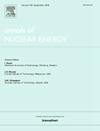Direct NeTS sampling of nuclear graphite S(α,β,T) in Serpent
IF 1.9
3区 工程技术
Q1 NUCLEAR SCIENCE & TECHNOLOGY
引用次数: 0
Abstract
For advanced reactor applications, Neural Thermal Scattering (NeTS) modules were developed to predict the thermal scattering law (TSL or ) of a nuclear graphite neutron moderator. NeTS are multi-layer, feedforward artificial neural networks, which act as universal function approximators designed for TSL datasets. In this case, a 4-layer neural network with 164 neurons per layer is trained using FLASSH evaluated data in PyTorch and serialized as a torchscript dictionary to predict on-the-fly. Relative, absolute and maximum percent deviations of NeTS from File 7 data generated using the FLASSH code are on the order of 0.01%, 0.1% and 1%, respectively, with low inference latencies of 0.000172 s per at a given temperature. Capturing the full dimensionality of possible inelastic neutron-lattice interactions, NeTS functionality is embedded in the Serpent Monte Carlo code, where sampling is conducted on-the-fly and compared to ACE look-up-tables for predicting TREAT criticality. k-eff differences between sampling algorithms of 6 pcm are observed and are within the order of Monte Carlo uncertainty. Compared to discrete and continuous-energy ACE files (30 MB and 131 MB per temperature), the NeTS format is on the order of 200–300 kB for a continuous-temperature, interpolation-free representation of and cross sections. NeTS-in-Serpent runtimes comparable with ACE look-up tables are achieved by scaling NeTS for high performance computing architectures with hybrid OpenMP + MPI parallelization. This work validates a novel, self-contained reactor physics framework for predictive cross sections, and demonstrates a general methodology for embedding modern machine learning libraries within existing neutronic analysis frameworks.
蛇核石墨S(α,β,T)的直接NeTS取样
针对先进反应堆应用,开发了神经热散射(NeTS)模块来预测核石墨中子慢化剂的热散射规律(TSL或S(α,β,T))。net是一种多层前馈人工神经网络,作为TSL数据集的通用函数逼近器。在这种情况下,一个每层164个神经元的4层神经网络使用flash在PyTorch中评估数据并序列化为火炬脚本字典进行训练,以实时预测S(α,β,T)。使用flash代码生成的File 7数据的net的相对、绝对和最大百分比偏差分别为0.01%、0.1%和1%,在给定温度下的推断延迟为0.000172 s / s α,β,T。捕获可能的非弹性中子-晶格相互作用的全维度,net功能嵌入在Serpent Monte Carlo代码中,其中s - α,β,TNeTS采样是实时进行的,并与ACE查找表进行比较,以预测TREAT临界性。观察到6 pcm采样算法之间的k-eff差异,并且在蒙特卡罗不确定性的量级内。与离散和连续能量的ACE文件(每个温度30 MB和131 MB)相比,NeTS格式在200-300 kB左右,用于连续温度,无插值表示S(α,β,T)和截面。net -in- serpent运行时可与ACE查找表相媲美,是通过使用混合OpenMP + MPI并行化将net扩展到高性能计算架构来实现的。这项工作验证了一种新的、独立的预测截面反应堆物理框架,并展示了在现有中子分析框架中嵌入现代机器学习库的一般方法。
本文章由计算机程序翻译,如有差异,请以英文原文为准。
求助全文
约1分钟内获得全文
求助全文
来源期刊

Annals of Nuclear Energy
工程技术-核科学技术
CiteScore
4.30
自引率
21.10%
发文量
632
审稿时长
7.3 months
期刊介绍:
Annals of Nuclear Energy provides an international medium for the communication of original research, ideas and developments in all areas of the field of nuclear energy science and technology. Its scope embraces nuclear fuel reserves, fuel cycles and cost, materials, processing, system and component technology (fission only), design and optimization, direct conversion of nuclear energy sources, environmental control, reactor physics, heat transfer and fluid dynamics, structural analysis, fuel management, future developments, nuclear fuel and safety, nuclear aerosol, neutron physics, computer technology (both software and hardware), risk assessment, radioactive waste disposal and reactor thermal hydraulics. Papers submitted to Annals need to demonstrate a clear link to nuclear power generation/nuclear engineering. Papers which deal with pure nuclear physics, pure health physics, imaging, or attenuation and shielding properties of concretes and various geological materials are not within the scope of the journal. Also, papers that deal with policy or economics are not within the scope of the journal.
 求助内容:
求助内容: 应助结果提醒方式:
应助结果提醒方式:


